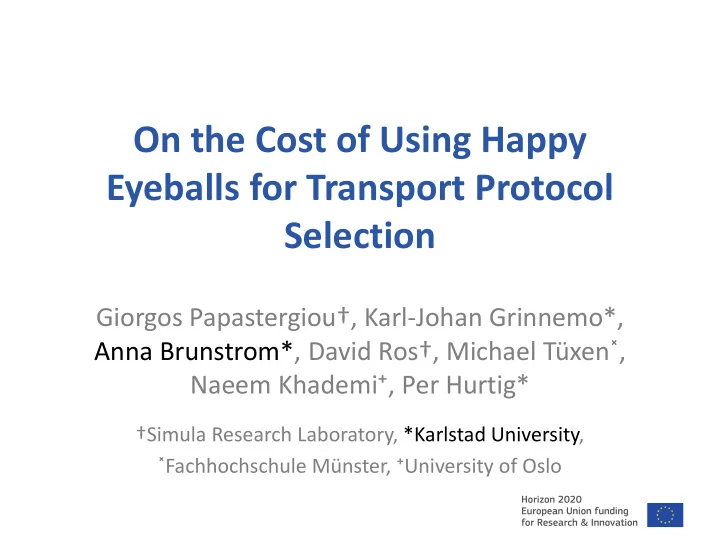

On the Cost of Using Happy Eyeballs for Transport Protocol Selection Giorgos Papastergiou†, Karl-Johan Grinnemo*, Anna Brunstrom*, David Ros†, Michael Tüxen˟, Naeem Khademi⁺, Per Hurtig* †Simula Research Laboratory, *Karlstad University, ˟ Fachhochschule Münster , ⁺ University of Oslo
Introduction • Deployment of new transport protocols is a difficult task • How to know if a new protocol is supported along the whole end-to-end path? – Try it • If not supported a fallback mechanism is needed – Testing protocols serially can be time consuming • Happy Eyeballs for transport protocol selection 2 7/15/2016
Happy Eyeball Example: TCP and SCTP • Concurrent initiation of TCP and SCTP • Preferred connection attempt wins 3 7/15/2016
Related Work • Happy Eyeballs introduced as a way of promoting the use of IPv6 [RFC6555] • Transport Happy Eyeballs was proposed as a mecahnism to run HTTP over SCTP [Wing10] • Ongoing work in IETF TAPS WG – “… explain how to select and engage an appropriate protocol and how to discover which protocols are available for the selected service between a given pair of end points” [RFC6555] D. Wing and A. Yourtchenko. Happy Eyeballs: Success with Dual-Stack Hosts. RFC 6555 (Proposed Standard), Apr. 2012. [Wing10] Wing, D. and P. Natarajan, "Happy Eyeballs: Trending Towards Success with SCTP", https://tools.ietf.org/html/ draft-wing-tsvwg-happy-eyeballs-sctp-02 (work in progress), October 2010. 4 7/15/2016
Cost of Happy Eyballs? • Increased server load – CPU load – Memory usage • Increased network traffic • Goal: Assess impact of happy Eyeballs on server load 5 7/15/2016
Experiment • Length of each test run: 600 s • Exponentially distributed http reqs. – [100,1000] reqs./s • Metrics: – CPU utilization – Kernel memory usage 6 7/15/2016
Basic Test Case Always results in a TCP connection • No caching of previous connection attempts • Unencrypted connections • 7 7/15/2016
CPU Utilization in Basic Test Case 10 Requested object size = 1 KByte 9 Requested object size = 35 KBytes 8 7 CPU utilisation (%) 6 5 4 3 2 1 0 TCP SCTP HE-TCP TCP SCTP HE-TCP TCP SCTP HE-TCP TCP SCTP HE-TCP 100 400 700 1000 Average request rate (requests/s) 8 7/15/2016
Memory Usage in Basic Test Case 35 Requested object size = 1 KByte Requested object size = 35 KBytes 30 Kernel memory usage (MBytes) 25 20 15 10 5 0 TCP SCTP HE-TCP TCP SCTP HE-TCP TCP SCTP HE-TCP TCP SCTP HE-TCP 100 400 700 1000 Average request rate (requests/s) 9 7/15/2016
TLS Test Case No caching of previous connection attempts • TLS-encrypted connections • 10 7/15/2016
CPU Utilization in TLS Test Case 30 25 20 CPU utilisation(%) 15 10 5 0 TCP SCTP HE-TCP TCP SCTP HE-TCP TCP SCTP HE-TCP TCP SCTP HE-TCP 100 400 700 1000 Average request rate (requests/s) 1K 35K 11 7/15/2016
Sharing of CPU load in TLS Test Case 12 7/15/2016
Memory Usage in TLS Test Case 35 30 Kernel memory usage (MBytes) 25 20 15 10 5 0 TCP SCTP HE-TCP TCP SCTP HE-TCP TCP SCTP HE-TCP TCP SCTP HE-TCP 100 400 700 1000 Average request rate (requests/s) 1K 35K 13 7/15/2016
Cache Test Case Caching of previous connection attempts • Both unencrypted and TLS-encrypted • connections HE-TCP: always results in a TCP connection – HE-SCTP: always results in a SCTP connection – HE-50%: 50% chance TCP/SCTP connection – 14 7/15/2016
Cache Hit Ratio vs. CPU Utilization Unencrypted TLS-encrypted 1 KiB 35 KiB 15 7/15/2016
Conclusion • Happy Eyeball is a feasible transport-selection mechanism • Small increase in CPU utilization – Around 10% for 35 KiB web objects – Encryption has larger impact on CPU load – Caching can reduce load further • Basically no increase in memory usage 16 7/15/2016
Future Work • More extensive evaluations with more than two feasible transport solutions • Transport service library with Happy Eyeballs support – https://github.com/NEAT-project/neat • Evaluation of Happy Eyeball in real-world scenarios with middleboxes etc. 17 7/15/2016
Recommend
More recommend